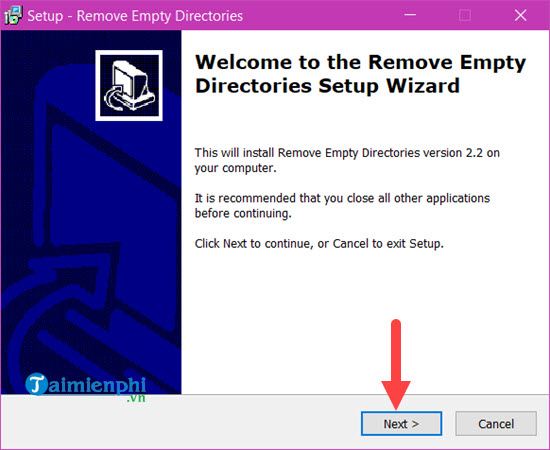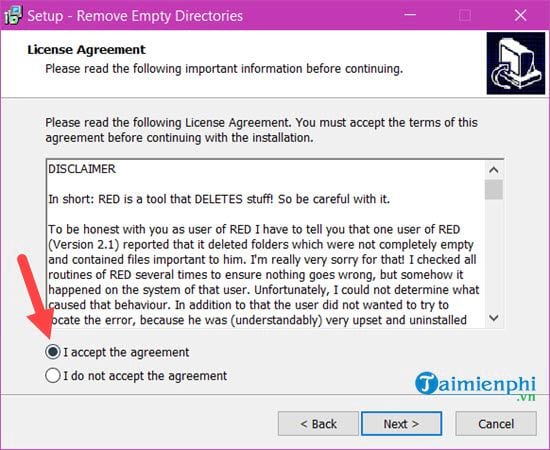Instructions to delete empty folders in Windows computer
Deleting empty folders in Windows computers helps free up memory and clean up the system. You can do it using CMD, PowerShell or specialized software like Remove Empty Directories.
How to delete empty folders in Windows computer
Step 1: Download Remove Empty Directories here and install it.
Step 2: After downloading Remove Empty Directories, proceed to install this software normally.

Step 3: Agree to the terms of the Remove Empty Directories software by clicking I accept the agreement .

Step 4: Select the path for the Remove Empty Directories software, otherwise leave it as default and click Next .

Step 5: Then click Next continuously until the word Install appears to proceed with installing Remove Empty Directories.

Step 6: Finally, click Finish to complete the Remove Empty Directories installation process.

Step 7: Note that to delete stubborn folders you need to start Remove Empty Directories in Admin mode .

Step 8: The Remove Empty Directories interface appears, you just need to click Scan Folders according to the drive you selected to search for empty folders.

Step 9: The scanning process is quite fast, the number of folders appears and you just need to click on Delete Folders .

Step 10: In contrast to the scanning process, this process will take quite a long time and not 100% of the folders will be deleted.

As shown below, we can only delete 1274 folders and there are 551 protected folders so we cannot delete them using Remove Empty Directories.

Step 11: Readers can check the Log file to know which files were deleted and which could not be deleted.

Additionally, in the Settings section you have the right to add types of extensions that are not deleted as well as specified folders that are not scanned.

Although it is not possible to delete all empty folders in Windows computers, but with the way you do it, it will still help reduce unnecessary folders, optimizing storage space. If you encounter folders that cannot be deleted, they may be important system folders or are in use. To clean up your computer more effectively, you can combine Remove Empty Directories with support tools such as CCleaner, which helps remove junk files, unused folders and optimize computer performance.
You should read it
- Instructions for fixing errors 'Cannot delete folder: The directory is not empty'
- How to delete all empty folders, junk folders on Windows 10
- Search and delete empty folders on Windows using PowerShell
- How to fix errors cannot clean up Trash on Mac
- Delete Files on Mac - Empty Trash or Secure Empty Trash?
- What is the error This folder is empty? How to fix it?
- What is the Windows.old folder and how do you delete it?
- Delete empty data cells in Excel 2007 or 2010
May be interested
- What is the directory $ WINDOWS. ~ BT, can delete $ WINDOWS. ~ BT or not?
 folders such as $ windows. ~ bt and $ windows. ~ ws are directories related to the windows 10 upgrade process. these folders may appear on windows 7, 8 and 10 and more. , these folders are hidden folders, so to see these directories you have to perform some additional operations to display the directory.
folders such as $ windows. ~ bt and $ windows. ~ ws are directories related to the windows 10 upgrade process. these folders may appear on windows 7, 8 and 10 and more. , these folders are hidden folders, so to see these directories you have to perform some additional operations to display the directory. - Delete empty data cells in Excel 2007 or 2010
 in the following article, we will show you some basic actions to delete empty cells in excel 2007 or 2010 spreadsheet. first, open the spreadsheet and press ctrl + a to select all, or select certain data to apply ...
in the following article, we will show you some basic actions to delete empty cells in excel 2007 or 2010 spreadsheet. first, open the spreadsheet and press ctrl + a to select all, or select certain data to apply ... - How to assign permissions to delete any folder or file on Windows?
 in some cases when you delete a folder or file on a windows computer but cannot delete it and on the screen that displays an error message you need permission to perform this action. in order to be able to delete folders and files, you must assign permission permissions to delete them.
in some cases when you delete a folder or file on a windows computer but cannot delete it and on the screen that displays an error message you need permission to perform this action. in order to be able to delete folders and files, you must assign permission permissions to delete them. - 5 Windows files and folders can be deleted to free up space
 windows contains many unnecessary files and folders from hidden cache, old files you can delete them to free up space. but to know whether it is safe to delete folders and files is safe.
windows contains many unnecessary files and folders from hidden cache, old files you can delete them to free up space. but to know whether it is safe to delete folders and files is safe. - How to delete stubborn folders on your computer easily
 how to delete stubborn folders on your computer easily. on any operating system, there are stubborn folders that we can not delete by the basic delete command. when we delete the stubborn folder, the operating system will constantly report an error that cannot be deleted, please try again. there are many reasons why folder cannot be deleted
how to delete stubborn folders on your computer easily. on any operating system, there are stubborn folders that we can not delete by the basic delete command. when we delete the stubborn folder, the operating system will constantly report an error that cannot be deleted, please try again. there are many reasons why folder cannot be deleted - 6 ways to permanently delete files on Windows - You will not be able to get that file back again
 normally, when deleting a file on windows, the file will not be deleted immediately but will be saved in the recycle bin. after that, you will have to do one more step: empty the trash. but if you don't want to have to do this second step, we will show you how to permanently delete a file in the article below.
normally, when deleting a file on windows, the file will not be deleted immediately but will be saved in the recycle bin. after that, you will have to do one more step: empty the trash. but if you don't want to have to do this second step, we will show you how to permanently delete a file in the article below. - 7 files and folders Windows can delete to free up space
 windows contains many unnecessary files and folders from hidden caches, old files you can delete to free up space. but knowing whether it is safe to delete those folders and files seems to be a challenge.
windows contains many unnecessary files and folders from hidden caches, old files you can delete to free up space. but knowing whether it is safe to delete those folders and files seems to be a challenge. - Instructions for deleting empty lines and columns in Excel 2016
 sometimes your spreadsheet has too many blank lines and empty columns look very messy and lose aesthetics. to make the spreadsheet look better you can delete these blank lines and blank columns. however, instead of manually deleting each column, each blank line is very time-consuming, especially with long spreadsheets with many empty columns and empty lines.
sometimes your spreadsheet has too many blank lines and empty columns look very messy and lose aesthetics. to make the spreadsheet look better you can delete these blank lines and blank columns. however, instead of manually deleting each column, each blank line is very time-consuming, especially with long spreadsheets with many empty columns and empty lines. - 3 ways to delete recent files and folders in Windows
 each successive version of windows has had features that reach out to things you've recently opened, such as jump lists that let you open things you've been working on with certain applications.
each successive version of windows has had features that reach out to things you've recently opened, such as jump lists that let you open things you've been working on with certain applications. - The simplest way to show and hide folders on Windows 10
 by hiding folders on windows 10 computers, users can hide them without anyone knowing. especially for folders containing important files and documents, hiding folders on windows 10 is extremely necessary. to know how to hide and show folders on windows 10, readers can refer to the instructions below and follow the steps.
by hiding folders on windows 10 computers, users can hide them without anyone knowing. especially for folders containing important files and documents, hiding folders on windows 10 is extremely necessary. to know how to hide and show folders on windows 10, readers can refer to the instructions below and follow the steps.










 How to install Free PDF Compressor, software to reduce PDF size on your computer
How to install Free PDF Compressor, software to reduce PDF size on your computer Top 5 best free decompression software on Windows
Top 5 best free decompression software on Windows The fastest way to send large files
The fastest way to send large files 7 tips to free up space in Google Drive
7 tips to free up space in Google Drive 4 Privacy-Focused Google Photos Alternatives
4 Privacy-Focused Google Photos Alternatives Why use 1Password instead of Google Authenticator?
Why use 1Password instead of Google Authenticator?